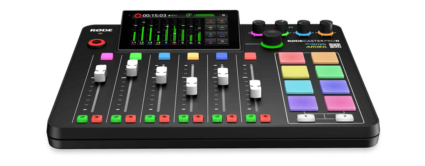Rodecaster Pro 2
The Rodecaster Pro has been a popular device for podcasters, streamers, musicians and other creatives for many years. For example, we have been using it in the editorial office for years to record our iCulture podcast. The new Rodecaster Pro 2 has nine different channels, six hardware faders, three virtual faders and multiple inputs for your microphones, guitars, computers and more. You can record all kinds of audio with it via the 3.5mm connection, your iPhone and iPad or a Bluetooth device. Then you can control the audio from each source separately. The new model works with more microphones, including demanding ones like the Shure SM7B. It's also more compact and has an improved color touchscreen.
A setup assistant will help you on your way, after which you can explore on your own to further improve your sound. The 1.5GHz quad-core audio engine handles the processing of multiple audio streams and ensures that you record with minimal noise. Some microphones (such as Rode's own Podcaster, Procaster and NT1) have presets, so they are immediately set up for optimal sound.


The Rodecaster has so-called smart pads, special hardware buttons that allow you to control sound effects, ducking, live sampling and the like – ideal for your talk show. Another notable feature is the back channel, where users can confer with each other without being recorded or heard in the live stream. You do not have to interrupt your recording. You can record directly to microSD or SSD via a USB connection. There are also fixed settings for different shows, useful if you sometimes make a podcast and at other times do a live stream of your gaming activities. You are then using the same device but the settings are different.

The Rodecaster Pro 2 will be in stores from June. Like its predecessor, it is not cheap. It has even become a bit more expensive: you pay $700 in the US. The pro-order already starts.
Below you can see the prices of the current model:

